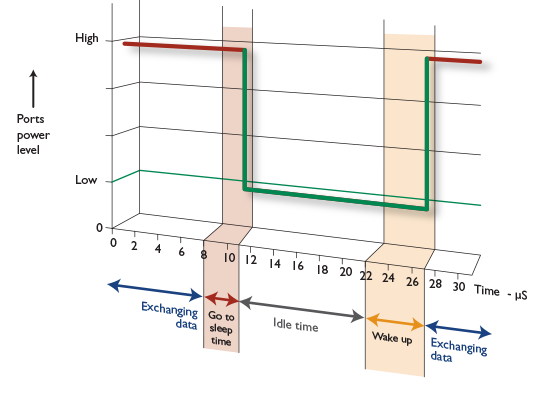Energy Efficient Ethernet (EEE)
Ethernet is the technology that drives most networks – from corporate LANs to the backbone of the Internet. It is a technology that is mature, highly reliable, and enormously popular.
Therefore, considerable effort is being devoted to the optimization of this technology. When something becomes as prevalent as Ethernet has, the benefits of any incremental improvement are substantial.
Over the preceding decades, the effort that has been put into improving the throughput, flexibility, and cost of Ethernet has transformed the way that businesses use data, and has brought remarkable communication options into the lives of vast numbers of people throughout the world.
More recently, attention has also turned to the impact that Ethernet devices are having on the world’s energy consumption. If ways can be found to reduce the energy consumption of these devices, then we can achieve valuable reductions in the environmental impact, and running costs, of data networks. Reductions in energy consumption by these devices also have add-on effects as less heat is generated, which results in less energy being consumed for environmental conditioning.
When serious attention is devoted to optimizing an aspect of a technology, then usually significant gains are made quite quickly. This has certainly been the case with the energy-use optimzation of Ethernet.
The IEEE group working on Ethernet energy efficiency has identified that a sizable amount of power was being used unnecessarily to keep the transmit circuitry of Ethernet interfaces active, even when they had no data to transmit.
The fact is that the majority of Ethernet links, especially at the edge of a network, have utilizations of less than 10%. The network interfaces in PCs, and other connected devices, are not constantly communicating with the network, but spend much of their time quiet. So, their transmit circuitry is idle for around 90% of the time.
The IEEE working group devised a mechanism for saving power by enabling the transmit circuitry to go into low-power mode when idle, and rapidly return to a fully active mode when data needs to be transmitted.
This mechanism has been ratified as a standard that is commonly referred to as Energy Efficient Ethernet (EEE).
 A compelling feature of EEE is its ability to take advantage of even very brief idle periods. An EEE port will move to low-power mode within just a few microseconds of no data. On a 10Gigabit port, the port can be down to low power in about 3 microseconds after sending a packet. So, power is not saved just in the long idle periods, but in all the thousands of brief idle periods that occur even when a workstation is active. This propensity for ports to transition to low power at every little opportunity would be bothersome if the power-up time were lengthy, as that would add latency to data communication. However, EEE also has a rapid power-up time. So, EEE takes the opportunity to save power in those brief idle moments, without adding significant delay to data delivery.
A compelling feature of EEE is its ability to take advantage of even very brief idle periods. An EEE port will move to low-power mode within just a few microseconds of no data. On a 10Gigabit port, the port can be down to low power in about 3 microseconds after sending a packet. So, power is not saved just in the long idle periods, but in all the thousands of brief idle periods that occur even when a workstation is active. This propensity for ports to transition to low power at every little opportunity would be bothersome if the power-up time were lengthy, as that would add latency to data communication. However, EEE also has a rapid power-up time. So, EEE takes the opportunity to save power in those brief idle moments, without adding significant delay to data delivery.
Implementing this standard enables networking equipment to achieve real, tangible reductions in power consumption – savings of well over 50% of the energy used by Ethernet ports. In addition, equipment lifetimes are increased – less power dissipation means slower heat-induced deterioration of components.
Allied Telesis has embraced this standard, as due to the benefit it has for the planet and for our customers. Wherever possible, Ethernet interfaces in Allied Telesis equipment are now being developed as EEE-compliant interfaces.
Transitioning to an EEE-compliant network infrastructure does not require a fork-lift equipment upgrade. Allied Telesis EEE-capable Ethernet ports are fully backward compatible with pre-EEE ports. So EEE-capable equipment from Allied Telesis can be progressively introduced into a network without any need to overcome interoperability hurdles.
Reduced Operational Power Consumption
Using the latest technology and a range of power-saving techniques, Allied Telesis has reduced power consumption by up to 50% over a wide range of its network devices. Reducing power consumption has a direct benefit for the environment. Additionally, further energy savings can also be made where products are installed in air conditioned environments such as server rooms. Using less power has the distinct advantage to the user of lowering power utility bills, while also allowing the equipment to run cooler, increasing reliability.
 Eco-friendly is the brand name used by Allied Telesis to signify our low power range of networking products. Eco-friendly products will eventually encompass our entire product portfolio, as we continue to introduce new, lower power technology to meet customer demand.
Eco-friendly is the brand name used by Allied Telesis to signify our low power range of networking products. Eco-friendly products will eventually encompass our entire product portfolio, as we continue to introduce new, lower power technology to meet customer demand.
Reducing Power on Network Ports
The latest switching silicon can detect the length of cables connected to a port. Using “measure and minimize” technology, Allied Telesis can ensure that maximum power is only injected into cables with the longest lengths, while reducing the power injected into short cable lengths. Advanced products can ensure that selected ports are disabled overnight or at weekends, further reducing power consumption.
Reducing Indicator Activity
All networking devices feature a varying array of power-consuming indicator devices (typically LEDs) to aid in installation and diagnostics. On the latest Allied Telesis products, these LEDs can be disabled when not required, saving up to a further 2% of operating power.
Power Supply Efficiency
 The overall power consumption of a network device is ultimately dictated by the efficiency of the power supply. A power supply delivering only 50% efficiency draws twice the actual required power, with half the power wasted in the form of heat. Allied Telesis is now using ultra-efficient power supplies, delivering conversion efficiencies of more than 80%, which produce less heat and reduce power consumption by up to 30%. Allied Telesis is now rating power supplies, informing the user of their efficiency.
The overall power consumption of a network device is ultimately dictated by the efficiency of the power supply. A power supply delivering only 50% efficiency draws twice the actual required power, with half the power wasted in the form of heat. Allied Telesis is now using ultra-efficient power supplies, delivering conversion efficiencies of more than 80%, which produce less heat and reduce power consumption by up to 30%. Allied Telesis is now rating power supplies, informing the user of their efficiency.
